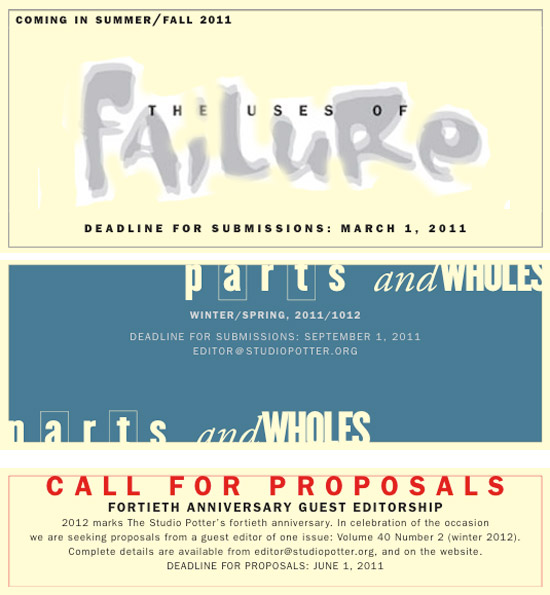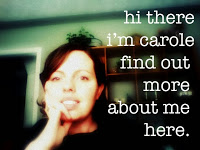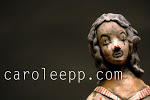guest post: “Look what I found.” Thoughts about pottery by Steve S. Saroff
into the school library to be alone during lunch recess. The most
private nook was the science section. The bottom shelf had the biggest
books. One of them was a mineralogy book filled with photos of
crystals and diagrams of chemical changes brought on by heat and
annealing. There were explanations about oxidation and reduction.
There were instructions of how to make a flame blow-pipe to use with a
candle to do tests on minerals. There were photos of aiming the tip of
the hot flame at mineral streaks made on the back of a ceramic tile.
The photos showed how colors would be different depending on which part
of the flame – the blue oxidizing center or the orange glow of
reduction – touched the trace of minerals.
with no goal is no comfort, but aimed at the discovery of the
mysterious, with observations of matters great and small, solitude is
the cure for even the deepest sorrow. You can go out then come back and
say, “Look. See what I have found.” The right sort of solitude leads
to the best sort of company.
I made a mineral test
kit: A hand lens; A tile as a streak plate for scraping rocks; A
candle; A pack of matches; A thin copper tube pinched at one end to
just a pin hole; A vial and eyedropper of weak hydrochloric acid; A
quartz crystal and a few other minerals for the hardness test. A small
notebook. A pencil. A Swiss army knife. Then I began looking for
rocks, especially ones with colors and crystals. And I found them. And
I brought them back.
Rocks rapidly led to geology —
which is the study of time– which led to chemistry – which is the study
of mystery . Chemistry led to math, which could have been perfect
except that I needed to work and make money, so math then pulled me
into writing software for computers which led to starting businesses.
Business is a deep sorrow which has nothing to do with the way minute
streaks of minerals look when heated to 2,300 degrees in the absence,
or presence of oxygen. Copper will become black or green. Iron is a
rainbow if combined with just a hint of manganese and a smudge of
silicate. These are things you can bring back. These are things that
can be shared.
When I met the woman who would become my
first wife, one of her classes was a pottery class. I went with her
one evening to the big studio on campus. Students were working on their
final projects and dipping bisqued cups into buckets of grey goop. In
the corner of the room was a cabinet filled with bottles. A 50’ish man
was sitting near the cabinet reading a newspaper and smoking a
cigarette, and when I walked over to read the labels on the bottles, he
said hello and asked if I was one of his students. I told him no, but
told him I was the boyfriend of a student of his. He nodded, almost
went back to reading his paper, but instead asked that universal small
talk question of universities, “what are you studying?”
“Chemistry,” I said.
lowered his paper, looked at me. At that time, out of the 6,000
students on campus, there were only a few handfuls of chemistry majors.
He asked, “Really?” and we began to talk. We talked about clays and
their extra layers of bonded hydrates. We talked about bonding energy
and valance. We talked about the physics of heat, of enthalpy, of
photons and how all things glow, even when cold. Then he said, “Hey,
let me show you how to throw a pot.”
My second wife
also liked pottery. She and I bought a used kick wheel and set up in
our backyard of the small house we shared for a few years on Missoula
avenue. But I was so busy with trying to make money that I don’t think I
ever touched the clay. And we had no kiln, so I never touched the
chemistry either. And then that marriage ran out and the wheel rusted
in the rain.
pottery. It is the perfect solitude. When I sat at a wheel and thought
too hard, nothing worked. But when I became alone without thoughts, my
hands calmed me. I’ve never needed to make any cups or plates or bowls
– there is always something to drink or eat from – and I’ve never
needed art credits or a social purpose to define myself — but I have,
ever since I was ten, needed discovery and surprise. Pottery can be
that, and it is also has discoveries that can be shared. The “Hey,
look at what I found,” like the rocks I carried back from mountain
tops, rocks with fossils or metal crystals, rocks with mystery. Perfect
solitude brings people together because we can share what we have
learned alone.
re-learning how to throw porcelain. I spend hours just centering, and
most of what I have done ends up in the slip bucket.
In the mood for some great writing about ceramics?
Look no further than Damon Moon’s website which you’ll find here.
Here’s just a few of the topics he covers:
Free Radicals: the rhetoric of innovation in contemporary ceramics (2009)
A State of Flux: The Future of Australian Ceramics Education
A Secret History of Blue and White: Contemporary Australian Ceramics
Makes me wish I had more time for writing myself…and reading for that matter.
British Ceramics Biennial and Ceramic Review Writing Prize
Upcoming Studio Potter deadlines

Please visit their website for more info.










